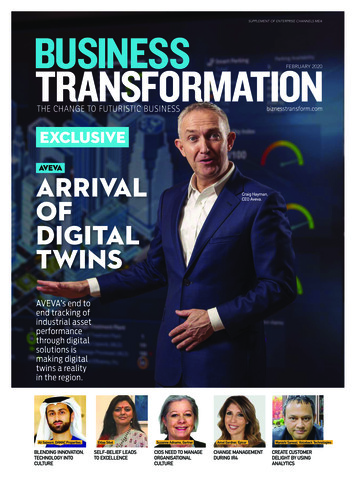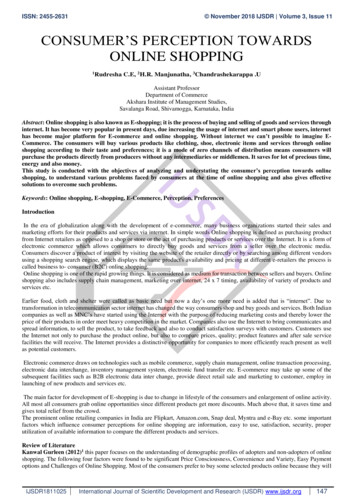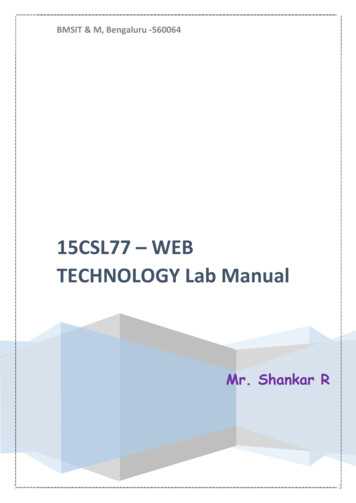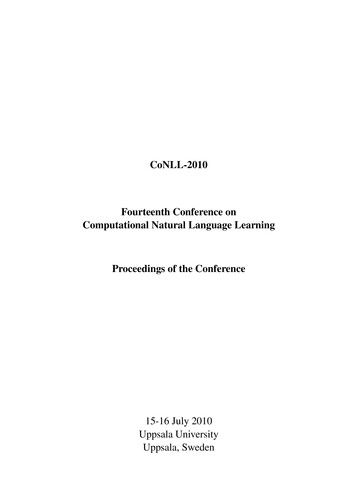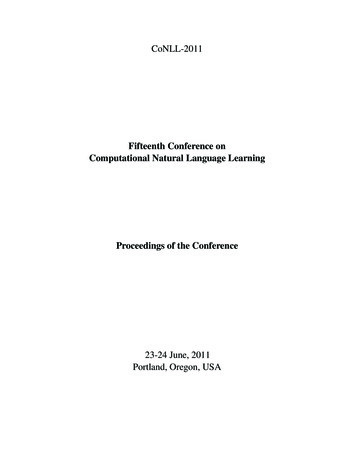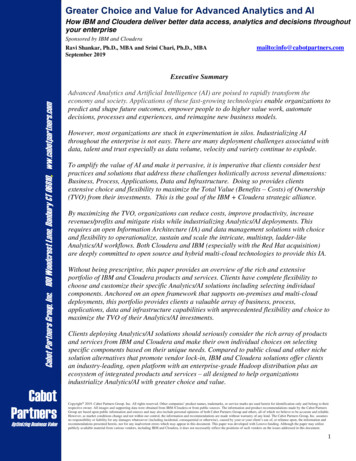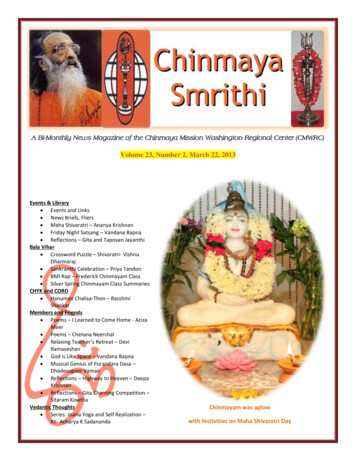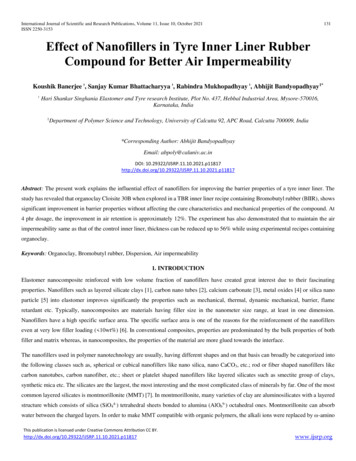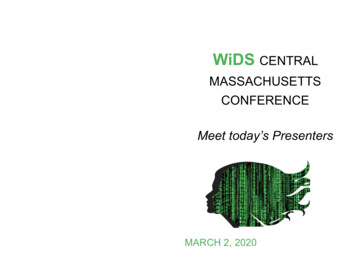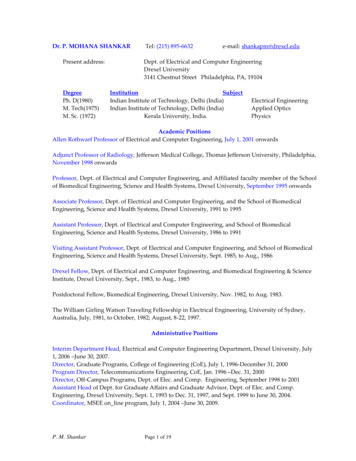
Transcription
Dr. P. MOHANA SHANKARPresent address:DegreePh. D(1980)M. Tech(1975)M. Sc. (1972)Tel: (215) 895-6632e-mail: shankapm@drexel.eduDept. of Electrical and Computer EngineeringDrexel University3141 Chestnut Street Philadelphia, PA, 19104InstitutionSubjectIndian Institute of Technology, Delhi (India)Indian Institute of Technology, Delhi (India)Kerala University, India.Electrical EngineeringApplied OpticsPhysicsAcademic PositionsAllen Rothwarf Professor of Electrical and Computer Engineering, July 1, 2001 onwardsAdjunct Professor of Radiology, Jefferson Medical College, Thomas Jefferson University, Philadelphia,November 1998 onwardsProfessor, Dept. of Electrical and Computer Engineering, and Affiliated faculty member of the Schoolof Biomedical Engineering, Science and Health Systems, Drexel University, September 1995 onwardsAssociate Professor, Dept. of Electrical and Computer Engineering, and the School of BiomedicalEngineering, Science and Health Systems, Drexel University, 1991 to 1995Assistant Professor, Dept. of Electrical and Computer Engineering, and School of BiomedicalEngineering, Science and Health Systems, Drexel University, 1986 to 1991Visiting Assistant Professor, Dept. of Electrical and Computer Engineering, and School of BiomedicalEngineering, Science and Health Systems, Drexel University, Sept. 1985, to Aug., 1986Drexel Fellow, Dept. of Electrical and Computer Engineering, and Biomedical Engineering & ScienceInstitute, Drexel University, Sept., 1983, to Aug., 1985Postdoctoral Fellow, Biomedical Engineering, Drexel University, Nov. 1982, to Aug. 1983.The William Girling Watson Traveling Fellowship in Electrical Engineering, University of Sydney,Australia, July, 1981, to October, 1982; August, 8-22, 1997.Administrative PositionsInterim Department Head, Electrical and Computer Engineering Department, Drexel University, July1, 2006 –June 30, 2007.Director, Graduate Programs, College of Engineering (CoE), July 1, 1996-December 31, 2000Program Director, Telecommunications Engineering, CoE, Jan. 1996 –Dec. 31, 2000Director, Off-Campus Programs, Dept. of Elec. and Comp. Engineering, September 1998 to 2001Assistant Head of Dept. for Graduate Affairs and Graduate Advisor, Dept. of Elec. and Comp.Engineering, Drexel University, Sept. 1, 1993 to Dec. 31, 1997, and Sept. 1999 to June 30, 2004.Coordinator, MSEE on line program, July 1, 2004 –June 30, 2009.P. M. ShankarPage 1 of 19
Awards and Honors 2005-2006 Christian R. and Mary F. Lindback Foundation Award for Distinguished Teachingin the University Recognized by the Institute of Physics (IOP), U. K. as one of 100 authors who have publishedpapers that were key to the advancement of physics research in their particular subject area(April 2006) http://www.iop.org/ej/authors edition/ Martin Kaplan distinguished service award, ECE department 2005 Outstanding Service Award, College of Engineering, 2003. Named Allen Rothwarf Professor of Electrical and Computer Engineering, July 1, 2001 Faculty Achievement award, College of Engineering, 1999. William Girling Scholarship, University of Sydney, 1981, 1997Programs Developed Master of Science in EE/Telecommunications Engineering Master of Engineering Master of Science in Software Engineering Special Programs: Dean's Fellowship, Career-Integrated-Education (CIE), Fellowship forB.S./M.S. students BS in Software EngineeringCourses and Laboratories Developed1. Interdisciplinary UG course in Probability for Engineers;P. M. Shankar (Coordinator), A. Reddy (Civil and Arch. Engg.), A. Wang (Mech. Engg.) and M. Grady(Chem. Engg.)2. Engineering Horizons (with Raj Mutharasan of Chem. Engg.) UG Junior/Senior Level3. Wireless CommunicationsUG Junior Level4. Lightwave Engineering I, II and IIIUG Senior Level5. Fiberoptics and Optical Communications I, II, IIIGraduate Level6. Fiberoptic and Integrated Optic DevicesGraduate LevelLaboratoriesUG Senior LevelLightwave Engineering LaboratoryCourses TaughtUndergraduateCommunication Theory (Junior Level), 1983/84 to 1988/89, 1995/96, 1996/97Communications (Senior Level) 1998/99, Winter 2004-2005Dynamic Engineering Systems (Sophomore level) 2010/11, 2011/12, 2012/13, 2013/2014E M Theory (Junior Level), 1984/85Electronics I (Junior Level), 1986/87Engineering Applications of Probability (Junior Level) 1997/98-2001/2002Engineering Horizons (Junior Level) 2000/’01 and 2001/2002Freshmen Design 2005-2006, 2006-2007, 2008Lightwave Engineering I, II and III (Senior Level), 1987/88 to 1995/96Linear Engineering Systems (Sophomore level) 2010/11, 2011/12, 2012/13,2013/2014Nondeterministic Systems (Junior Level), 1983/84, 1984/85, 1987/88, 1995/96, 1996/97Probability for Engineers (Junior Level) 2014-2015University Seminar (Undergraduate Freshmen), 1991/92, 1992/93, 2003/2004, 2004/2005P. M. ShankarPage 2 of 19
Wireless Communications (Junior Level) 1997/98 onwardsGraduateAdvanced Wireless Channel modeling 2011/2012Stochastic Systems I 1997/98, 1999/2000, 2004/2005Electrooptics and Optical Processing, 1983/84Fiber Optic and Integrated Optic Devices, 1989/90Fiber Optics and Optical Communications--I, II, and III, 1985/86 to 1994/95, Fall 1994, Fall 2008 ,2010/11Graduate Students SupervisedDoctoral10. Angela Leung (Chem. Engg.) Detection of cells, proteins, and DNA using Tapered Fiber OpticsBiosensors (TFOBS), (Joint advising with Dr. R. Mutharasan, Dept of Chemical & Biological Engg.) June2007.9. V. A. Dumane (Elec. Engg.) Diversity and Compounding for Enhanced Discrimination of Breast Masses inUltrasonic B-Scan Images, November 2002.8. P. Dala Krishna (Biomed. Engg.) Modeling and characterization of ultrasound contrast agents, August1998.7. J. Koshy (Elec. Engg.) Modeling and evaluation of fiber-fed microcellular systems, June 1997.6. R. Molthen (Biomed. Engg.) Ultrasonic tissue characterization using non-Rayleigh statistics, June 1996.5. V. M. Narayanan (Biomed. Engg.) Non-Rayleigh statistics of ultrasonic backscattered echoes, June 1996.4. Y. Q. Wu (Biomed. Engg.) Development of a fiberoptic sensor using light diffraction technique, (Jointadvising with Dr. P. Lewin, School of Biomedical Engineering, Science and Health Systems) Sept. 19933. T. J. Brophy (Elec. Engg.) Optical fiber tapers: formation, modeling, and characterization, June 1993.2. D. P. Koller (Elec. Engg.) Characterization of acoustical noise from bubble clouds in the ocean, Dec. 1992.1. Yue Li (Biomed. Engg.) First order statistics of speckle around a scatterer volume density edge, (Jointadvising with Dr. V. L. Newhouse), July 1990.MastersH. Haddock (Chem. Engg); G. Bhagavatheeswaran (Biomed. Engg); T. George (EE); V. Dumane (EE);G. Prabhu (EE); J. Koshy (EE); G. George (Biomed. Engg); D. Koller (EE); B. Schrope (Biomed. Engg)P. M. ShankarPage 3 of 19
Book(s)/Chapters Published P. M. Shankar, Fading and Shadowing in Wireless Systems, Springer, 2012.P. M. Shankar, Introduction to Wireless Systems, John Wiley & Sons, 2001.P. M. Shankar, A. Reddy, A. Wang, and M. Grady, Statistical Analysis of Engineering Systems,Gateway Coalition, Drexel University, 2001.P. M. Shankar, ‘Propagation characteristics of wireless channels,’ Chapter in the InternetEncyclopedia on Wireless, H. Bidgoli (Ed.) John Wiley& Sons, 2003.P. M. Shankar and R. Mutharasan, ‘Tapered Fibers for Cell Studies,’ in Reviews in Fluorescence2005, Vol. 2, pp. 63-74, Chris Geddes and Joseph Lakowicz (Ed.), Springer, New York 2005.P. M. Shankar, ‘Wireless Channels,’ in Handbook on Wireless Information Security, John Wiley,(Ed. H. Bidgoli), July 2005.A. Leung, Raj Mutharasan and P. M. Shankar, ‘Evanescent Field Tapered Fiber OpticBiosensors (TFOBS): Fabrication, Antibody Immobilization and Detection,’ in Optical FibersResearch Advances, Nova Science Publishers (Ed. Jürgen C. Schlesinger), 2008.List of Publications since joining Drexel Universityh-index as of January 201729 (Web of Science)41 (Google Scholar)Papers in Refereed Journals111. P. M. Shankar, “A Matlab workbook on the pedagogy of generalized eigenvectors,"Accepted for publication in Computer Applications in Engineering Education110. P. M. Shankar, “Pedagogy of solutions to a set of linear equations using a Matlabworkbook," Accepted for publication in Computer Applications in Engineering Education109. P. M. Shankar, “Pedagogy of Cramer’s Rule and beyond: A Matlab workbook,”Mathematics & Computer Education, Fall2016, Vol. 50 Issue 3, pp. 207-215, December 2016108. P. M. Shankar, “Pedagogy of wireless fading channels: A Matlab demo,” InternationalJournal of Electrical Engineering Education, Vol. 53, No. 4, pp. 291-304, October 2016.107. P. M. Shankar, “Performance of cognitive radio in N*Nakagami cascaded channels,”Wireless Personal Communications, Vol. 88, Issue 3, pp. 657-667, June 2016.106. P. M. Shankar, “Pedagogy of autonomous differential equations and equilibria using aMatlab workbook,” Mathematics & Computer Education. Winter2016, Vol. 50 Issue 1, p. 57-72.105. P. M. Shankar, “Pedagogy of second order homogeneous differential equations: Aholistic approach using a Matlab workbook,” Computer Applications in Engineering Education,Vol. 24, No. 1, January 2016, pp. 114-121.104. P. M. Shankar, “An overview of shadowed fading wireless channels in terms of acascaded approach,” Physical Communication, Vol. 15, pp. 59-65, June 2015.P. M. ShankarPage 4 of 19
103. P. M. Shankar, “A composite shadowed fading model based on the McKay distributionand Meijer G functions,” Wireless Personal Communications, Vol. 81, Issue 3, pp. 1017-1030,March 2015.102. P. M. Shankar, “Statistics of boundaries in ultrasonic B scan images,” Ultrasound inMedicine and Biology, vol. 41, No. 1, pp. 268-280, January 2015.101. P. M. Shankar, “Error rates in dual hop wireless links operating in cascaded fadingchannels,” Wireless Personal Communications, Vol. 75, Issue 1, pp. 1-9, March 2014100. P. M. Shankar, “Computational study of the effects of shadowing in double scatteringwireless channels,” Australian J. of Electrical & Electronics Engg., Vol. 10, No. 4, pp. 542-55, Dec.2013.99. P. M. Shankar, “Diversity in cascaded N*Nakagami channels,” Annals ofTelecommunications, Vol. 68, Issue 7, pp. 477-483, July 2013.98. P. M. Shankar, “A statistical model for the ultrasonic backscattered echo from tissuecontaining microcalcifications,” IEEE Trans. UFFC, Vol. 60, No. 5, pp. 932-942, May 201397. P. M. Shankar, “Use of phase diversity and modified phase congruence for edge enhancementin ultrasonic imaging,” Signal, Image and Video Processing, Vol. 7, Issue 2, pp. 317-324, 2013.96. P. M. Shankar, “Maximal ratio combining (MRC) in shadowed fading channels in presence ofshadowed fading cochannel interference (CCI),” Wireless Personal Communications, Vol. 68, Issue 1,pp. 15-25, Feb. 2013.95. P. M. Shankar, “A pedagogic approach to cascaded fading channels and diversity inwireless systems,” Australian J. of Electrical & Electronics Engg., Vol. 9, No. 4, pp. 439-45, Dec.2012.94. P. M. Shankar, “A Nakagami-N-gamma model for shadowed fading channels,” WirelessPersonal Communications, Vol. 64, Issue 4, pp. 665-680, June 2012.93. P. M. Shankar, “A Matlab based demonstration of the effects of fading, shadowing anddiversity in wireless communications for undergraduate electrical engineering students,” Far EastJ. of Electronics and Communications, Vol. 7, No. 1, pp. 41 – 65, Sept. 2011.92. P. M. Shankar, “Statistical models for fading and shadowed fading channels in wirelesssystems: a pedagogical perspective,” Wireless Personal Communications, Vol. 60, No. 2, pp. 191-213,Sept. 2011.91. P. M. Shankar, “Maximal ratio combining in independent identically distributed N*Nakagamifading channels,” Proc. IET Communications, Vol. 5, No. 3, pp. 320–326, Feb 2011.90. P. M. Shankar, “Use of two dimensional phase-only-filters (POF) and compounding for specklereduction and edge detection in ultrasonic B scan images,” Applied Optics, Vol. 48, No. 29, pp.5589-5597, December 2009.P. M. ShankarPage 5 of 19
89. P. M. Shankar, “Quantitative measures of boundary and contrast enhancement in specklereduction in ultrasonic B mode images using spatial Bessel filters,” IEEE Trans. UFFC, Vol. 56, No.10, pp. 2086-2096, October 2009.88. P. M. Shankar, “Contrast enhancement and phase sensitive boundary detection in ultrasonicspeckle using Bessel spatial filters,” Proc. IET Image Processing, Vol. 3, No. 2, pp. 41-51, April 2009.87. P. M. Shankar, “Macro- and micro diversity in correlated shadowed fading channels,” IEEETrans. Vehicular Technology, Vol. 58, No. 2, pp. 727-732, Feb. 2009.86. P. M. Shankar, “Outage probabilities of a MIMO scheme in shadowed fading channels withmicro- and macrodiversity reception,” IEEE Trans. on Wireless Communications, Vol. 7, No.6, pp.2015-2019, June 2008.85. P. M. Shankar, “Analysis of microdiversity and dual channel macrodiversity in shadowedfading channels using a compound fading model,” AEUE (International Journal of Electronics andCommunications, Vol. 62, No.6, pp. 445-449, 2 June 2008.84. A. Leung, P. M. Shankar and R. Mutharasan, “Label-free detection of DNA hybridization usinggold-coated tapered fiber optic biosensors (TFOBS) in a flow cell at 1310 nm and 1550 nm,” Sensorsand Actuators B-Chemical, 131(2), 640-645, May 14, 2008.83. A. Leung, P. M. Shankar and R. Mutharasan, “Model protein detection using antibodyimmobilized tapered fiber optic sensors (TFOBS) in a flow cell at 1310 nm and 1550 nm,” Sensorsand Actuators B, Vol. B 129, 716–725, February 2008.82. A. Leung, P. M. Shankar and R. Mutharasan, “A review of fiber-optic biosensors,” Sensors andActuators (Chemical), Vol. B 125, Issue 2, pp. 688-703 , 8 August 2007.81. A. Leung, P. M. Shankar, R. Mutharasan, “Real time monitoring of bovine serum albumin atfemtogram/mL levels on antibody immobilized tapered fiber sensors,” Sensors and Actuators(Chemical), Vol. B 123, Issue 2, pp. 888-895, May 2007.80. P. M. Shankar, “Outage performance in wireless systems with multiple interferers subject toshadowing and fading using a compound fading model,” AEUE (International J. of Electronics andCommunications), Vol. 61,No. 4, pp. 255-261, April 2, 2007.79. P. M. Shankar, “Speckle reduction in ultrasonic images through a maximum likelihood basedadaptive filter,” Phys. Med. Biol., Vol. 51, pp. 5591–5602, 7 November, 200678. P. M. Shankar, “Performance analysis of diversity combining algorithms in shadowed fadingchannels,” Wireless Personal Comm., Vol. 37 (No. 1-2), pp. 61-72, April 2006.77. P. M. Shankar, “Comments on the effect of logarithmic compression on the estimation of theNakagami parameter for ultrasonic tissue characterization,” Phys. Med. Biol., Vol. 51, No 8, pp.L23-L26, April 2006.P. M. ShankarPage 6 of 19
76. A. Leung, K. Rijal, P. M Shankar and R. Mutharasan, “Effects of geometry on transmission andsensing potential of tapered fiber sensors,” Biosensors and Bioelectronics, Vol. 21, No. 12, pp. 22022209, June 2006.75. D. Maraldo, P. M Shankar and R. Mutharasan, “Measuring Bacterial Growth by Tapered Fiberand Changes in Evanescent Field,” Biosensors and Bioelectronics, Vol. 21, No. 7, pp. 1339-1344,January 2006.74. P. M. Shankar, “Outage probabilities in shadowed fading channels using a compoundstatistical model,” IEE Proc. Comm., Vol. 152, No.6, pp. 828-832, December 2005.73. K. Rijal, A. Leung, P. M Shankar and R. Mutharasan, “Detection of pathogen E. Coli O157:H7using antibody immobilized biconical tapered fiber sensors,” Biosensors and Bioelectronics, Vol. 21,No.6, pp. 871-880, December 2005.72. P. M. Shankar, C. W. Piccoli, J. M. Reid, F. Forsberg, B. B. Goldberg, “Application of thecompound pdf for characterization of breast masses in ultrasonic B scans,” Phys. Med. Biol., Vol.50, pp. 2241–2248, April 2005.71. P. M. Shankar, “Error rates in generalized shadowed fading channels,” Wireless PersonalComm., Vol. 28, pp. 233-238, February 2004.70. G. Bhagavatheeshwaran, W. T. Shi, F. Forsberg, and P M Shankar, “Subharmonic signalgeneration from contrast agents in simulated neovessels,” Ultrasound in Medicine and Biology, Vol.30, pp. 199-203, February 2004.69. P. M. Shankar, “The use of the compound pdf in ultrasonic tissue characterization,” Phys. Med.Biol., Vol. 49, pp. 1007–1015, February 2004.68. P. J. Wiejata, P. M. Shankar, and R. Mutharasan, “Fluorescent Sensing Using Biconical Tapers,”Sensors and Actuators, Vol. B 96, pp. 315–320, November 2003.67. H. S. Haddock, P. M. Shankar, and R. Mutharasan, “Fabrication of biconical tapered opticalfibers using hydrofluoric acid,” Material Science & Engineering – B, Vol. B 97, pp. 87-93, January2003.66. H. S. Haddock, P. M. Shankar, and R. Mutharasan, “Evanescent Sensing of biomolecules andcells,” Sensors and Actuators B, Vol. 88, pp. 67-74, 2003.65. P. M. Shankar, F. Forsberg, and L. Lown, “Statistical modeling of atherosclerotic plaque incarotid B mode images - A feasibility study,” Ultrasound in Medicine and Biology, Vol. 29, No. 9, pp.1305–1309, September 2003.64. P. M. Shankar, V. A. Dumane, C. W. Piccoli, J. M. Reid, F. Forsberg and B. B. Goldberg,“Computer-aided classification of breast masses in ultrasonic B scans using a multiparameterapproach,” IEEE Trans. on UFFC, Vol. 50, No. 8, pp. 1002-1009, August 2003.P. M. ShankarPage 7 of 19
63. P. M. Shankar, V.A. Dumane, T. George, C. W. Piccoli, J. M. Reid, F. Forsberg, B. B. Goldberg,“Classification of breast masses in ultrasonic B scans using Nakagami and K distributions,” Phys.Med. Biol., Vol. 48, No. 14, pp. 2229-2240, 21 July 2003.62. P. M. Shankar, “Estimation of the Nakagami parameter from log-compressed ultrasonicbackscattered envelopes,” J. Acoustical Soc. of Amer., Vol. 114, pp. 70-72, July 2003.61. P. M. Shankar, “A compound scattering pdf for the ultrasonic echo envelope and itsrelationship to K and Nakagami distributions,” IEEE Trans. on UFFC, Vol. 50, No. 3, pp. 339-343,March 2003.60. S. Gefen, O. J. Tretiak, C. W. Piccoli, K. D. Donohue, A. P. Petropulu, P. M. Shankar, V. A.Dumane, L. Huang, M. A. Kutay, V.Genis, F. Forsberg, J. M. Reid, B. B. Goldberg, “ROC analysisof tissue characterization classifiers for breast cancer detection,” IEEE Trans. on Medical Imaging,Vol. 22, No. 2, pp. 170-177, Feb. 2003.59. G. S. Prabhu and P. M. Shankar, “Performance Analysis of Fiber-Fed Microcellular Networksusing π/4-DQPSK in a Frequency Selective, CCI-limited, Nakagami Fading Environment,” IEEETrans. on Vehicular Technology, Vol. 51, No. 5, pp.1258-1264, September 2002.58. G. S. Prabhu and P. M. Shankar, “Simulation of flat fading using MATLAB for classroominstruction,” IEEE Trans. on Education, Vol. 45, No. 2, pp. 19-25, February 2002.57. P. M. Shankar, V. A. Dumane, C. W. Piccoli, J. M. Reid, F. Forsberg and B. B. Goldberg,“Classification of breast masses in ultrasonic B-mode images using a compounding technique inthe Nakagami distribution domain,” Ultrasound in Medicine and Biology, Vol. 28, No. 10, pp. 12951300, 2002.56. V. A. Dumane, P. M. Shankar, C. W. Piccoli, J. M. Reid, F. Forsberg and B. B. Goldberg,“Computer aided classification of masses in ultrasonic mammography,” Medical Physics, Vol. 29,No. 9, pp. 1968-1973, September 2002.55. V. A. Dumane, P. M. Shankar, C. W. Piccoli, J. M. Reid, V. Genis, F. Forsberg and B. B.Goldberg, “Classification of ultrasonic B-scan images of breast lesions using frequency diversityand Nakagami statistics,” IEEE Trans. on UFFC, Vol. 49, No. 5, pp. 664-668, May 2002.54. P. M. Shankar, “Ultrasonic tissue characterization using a generalized Nakagami model,” IEEETrans. on UFFC, Vol. 48, No. 6, pp. 1716-1720, November 2001.53. V. A. Dumane and P. M. Shankar, “Use of frequency diversity and Nakagami statistics inultrasonic tissue characterization,” IEEE Trans. on UFFC, Vol. 48, No. 4, pp. 1139-1146, July 2001.52. P. M. Shankar, V. A. Dumane, J. M. Reid, V. Genis, F. Forsberg, C. W. Piccoli, and B. B.Goldberg “Classification of ultrasonic B mode images of breast masses using Nakagamidistribution,” IEEE Trans. on UFFC, Vol. 48, No. 2, pp. 569-580, March 2001.51. P. M. Shankar, V. A. Dumane, J. M. Reid, V. Genis, F. Forsberg, C. W. Piccoli, and B. B.Goldberg, “Classification of masses in B-scan images of the breast using K-distribution,”Ultrasound in Medicine and Biology, Vol. 26, No. 9, pp. 1503-1510, 2000.P. M. ShankarPage 8 of 19
50. P. M. Shankar and B. A. Eisenstein, “Project based Instruction in Wireless Communications atthe Junior Level,” IEEE Trans. on Education, Vol. 43, No. 3, August 2000, pp. 245-249.49. P. M. Shankar, “A general statistical model for ultrasonic scattering from tissues,” IEEE Trans.on UFFC, Vol. 47, No. 3, pp. 727-736, May 2000.48. J. Koshy and P. M. Shankar, “Spread-Spectrum Techniques for Fiber-Fed MicrocellularNetworks,” IEEE Trans. on Vehicular Technology, Vol. 48, No. 3, pp. 847-857, May 1999.47. P. M. Shankar, P. D. Krishna, and V. L. Newhouse, “Subharmonic scattering properties ofultrasound contrast agents,” JASA, Vol. 106, No. 4, pp. 2104-2110, October 1999.46. P. D. Krishna, P. M. Shankar and V. L. Newhouse, “Subharmonic generation from UltrasonicContrast agents,” Physics in Med. Biology, Vol. 44, March 1999, pp. 681-694.45. J. Koshy and P. M. Shankar, “Effect of Nonlinearities on Outage Performance of Fiber-FedMicrocellular Networks for GMSK Systems,” IEEE Trans. on Vehicular Technology, Vol. 47, No. 3,pp. 819-829, Aug. 1998.44. P. M. Shankar, P. Dala Krishna, and V. L. Newhouse, “Advantages of Subharmonic overSecond Harmonic Backscatter for Contrast-to-Tissue Echo Enhancement,” Ultrasound in Medicine &Biology, Vol. 24, No. 2, pp. 395-399, 1998.43. R. C. Molthen, V. M. Narayanan, P. M. Shankar, J. M. Reid, V. Genis, F. Forsberg, E. J. Halpern,and B. B. Goldberg, “Using Phase Information in Ultrasonic Backscatter for In Vivo LiverAnalysis,” Ultrasound in Medicine & Biology, Vol. 24, No. 1, pp. 79-91, 1998.42. R. C. Molthen, P. M. Shankar, J. M. Reid, F. Forsberg, E. J. Halpern, C. W. Piccoli, and B. B.Goldberg, “Comparisons of the Rayleigh and K-distribution models using in vivo breast and livertissue,” Ultrasound in Medicine & Biology, Vol. 24, No. 1, pp. 93-100, 1998.41. B. J. Koshy and P. M. Shankar, “Performance Analysis of GMSK in Microcellular MobileSystems Employing Fiberoptic Feeders,” IEEE J. of SAC, Vol. 15, No. 4, pp. 694-706, May 1997.40. V. M. Narayanan, R. C. Molthen, P. M. Shankar, L. Vergara and J. M. Reid, “Studies OnUltrasonic Scattering from Quasi-Periodic Structures,” IEEE Trans. on UFFC, Vol. 44, pp. 114 – 124,January 1997.39. P. M. Shankar, R. Molthen, V. M. Narayanan, J. M. Reid, V. Genis, F. Forsberg, C. W. Piccoli, A.E. Lindenmayer and B. B. Goldberg, “Studies on the use of non-Rayleigh statistics for ultrasonictissue characterization,” Ultrasound in Medicine & Biology, Vol. 22, No. 7, 1996, pp. 873-882.38. P. M. Shankar, “A model for ultrasonic scattering from tissues based on K distribution,” Phys.Med. Biol., Vol. 40, pp. 1633-1649, October 1995.37. R. C. Molthen, P. M. Shankar and J. M. Reid, “Tissue Characterization in Ultrasonic B scansusing Non-Rayleigh Statistics,” Ultrasound in Med. & Biol., Vol. 21, No. 2, pp. 161-170, 1995.P. M. ShankarPage 9 of 19
36. Y. Q. Wu, P. M. Shankar, and P. A. Lewin, “Characterization of Ultrasonic Transducers using aFiberoptic Sensor,” Ultrasound in Medicine & Biology, Vol. 20, pp. 645-653, Oct. 1994.35. Y. Q. Wu, P. M. Shankar, P. A. Lewin and D. Koller, “Fiberoptic ultrasound sensor usingRaman-Nath light diffraction,” IEEE Trans. on UFFC, Vol. 41, pp. 166- 171, Mar. 1994.34. V. M. Narayanan, P. M. Shankar and J. M. Reid, “Non-Rayleigh Statistics of UltrasonicBackscattered Signals,” IEEE Trans. on UFFC, Vol. 41, pp. 845- 852, November 1994.33. D. Koller and P. M. Shankar, “Acoustic emissions from bubble clouds,” Ultrasonics, Vol. 32, No.3, pp. 229-233, May 1994.32. T. J. Brophy, P. M. Shankar, and Lloyd C. Bobb, “Formation and measurement of tapers inoptical fibers,” Rev. of Sci. Instrum., Vol. 64, no. 9, pp. 2650-2654, Sept. 1993.31. T. J. Brophy, L. C. Bobb and P. M. Shankar, “An in-line single-mode fibre interferometer viaconcatenated biconical tapers,” Electr. Letters, Vol. 29, No. 14, pp. 1276-77, 8th July 1993.30. P. M. Shankar, J. M. Reid, H. Ortega, C. W. Piccoli, and B. B. Goldberg, “Use of non-Rayleighstatistics for the identification of tumors in the ultrasonic B scans of the breast,” IEEE Trans. onMedical Imaging, Vol. 12, No. 4, pp. 687-692, Dec. 1993.29. D. P. Koller and P. M. Shankar, “Low frequency oscillations of bubble plumes,” JASA, Vol. 93,pp.1362-1365, Mar. 1993.28. L. Bobb and P. M. Shankar, “Tapered optical fiber components and sensors,” Microwave Journal,pp. 218-222, May 1992.27. Y. Li, V. L. Newhouse and P. M. Shankar, and P. Karpur, “Speckle reduction in ultrasonicsynthetic aperture images,” Ultrasonics, Vol. 30, pp. 233-237, July 1992.26. Y. Li, D. Koller, G. George, P. M. Shankar and V. L. Newhouse, “Underwater bubble sizingusing a double frequency technique,” J. Acoust. Soc. Amer., Vol. 92, pp. 1177- 79, Aug. 1992.25. D. Koller, Y. Li, P. M. Shankar, and V. L. Newhouse, “High speed bubble sizing using thedouble frequency technique for oceanographic applications,” IEEE J. Oceanic Engineering, Vol. 17,pp. 288-90, July 1992.24. Li Weng, J. Reid, P. M. Shankar, K. Soetanto and X. Lu, “Nonuniform phase distribution inultrasound speckle analysis I: Background and experimental demonstration,” IEEE Trans. onUFFC, Vol. 39, pp. 352- 359, May 1992.23. Li Weng, J. Reid, P. M. Shankar, K. Soetanto and X. Lu, “Nonuniform phase distribution inultrasound speckle analysis II: Parametric expression and a frequency sweeping technique tomeasure mean scatterer spacing,” IEEE Trans. on UFFC, Vol. 39, pp. 360-365, May 1992.22. P. M. Shankar, L. Bobb, and H. Krumboltz, “Coupling of modes in bent biconically taperedsingle mode fibers,” J. Lightwave Technology, Vol. 9, No. 7, pp. 832-37, July 1991.P. M. ShankarPage 10 of 19
21. L. Bobb, H. Krumboltz and P. M. Shankar, “A novel pressure sensor using bent biconicallytapered single mode fibers,” Optics Letters., Vol. 16, No. 2, Jan. 15, pp. 112-114, 1991.20. Li Weng, J. Reid, P. M. Shankar, and K. Soetanto, “Ultrasound speckle analysis using Kdistribution,” JASA, Vol. 89, pp. 2992- 2995, June 1991.19. L. Bobb, P. M. Shankar, and H. Krumboltz, “Bending effects in biconically tapered single modefibers,” J. of Lightwave Technology, Vol. LT- 8, pp. 1084-1090, July 1990.18. B. Schrope, P. M. Shankar and V. L. Newhouse, “In vitro detection and sizing of microbubblesusing a two frequency ultrasonic system,” ITBM, Vol. 11, No. 6, 1990, pp. 612-615.17. D. Cathignol, J. Y. Chapelon, V. L. Newhouse, and P. M. Shankar, “Bubble sizing with highspatial resolution,” IEEE Trans of UFFC, Vol. 37, pp. 30-37, Jan. 1990.16. P. M. Shankar, “Performance of LED-single mode fiberoptic Systems,” J. OpticalCommunications, Vol. 10, pp. 132-137, Dec. 1989.15. P. M. Shankar, “Modal redistribution and power loss in on-fiber devices,” Optical and QuantumElectronics, Vol. 21, pp. 321-329, May 1989.14. P. M. Shankar, “Bit error degradation due to modal noise in single mode fiberopticcommunication systems,” J. Opt. Comm., Vol. 10, No. 1, pp.19-23, March 1989.13. P. M. Shankar, P. Karpur, V. L. Newhouse and J. Rose, “Split spectrum processing: Analysis ofpolarity thresholding algorithm for the improvement of SNR and detectability of ultrasonicsignals,” IEEE Trans of UFFC, Vol. 36, pp. 101-108, Jan. 1989.12. P. M. Shankar, “Mode coupling in on-fiber devices,” Microwave and Optical Technology Letters,Vol. 1, pp. 291-293, Oct. 1988.11. P. M. Shankar, “Effect of modal noise on single mode fiber optic networks,” OpticsCommunications, Vol. 65, pp. 347-350, Mar. 1988.10. P. Karpur, P. M. Shankar, J. L. Rose and V. L. Newhouse, “Split spectrum processing:Determination of the available bandwidth for spectral splitting,” Ultrasonics, Vol. 26, pp. 204-209,July 1988.9. J. Y. Chapelon, V. L. Newhouse, D. Cathignol and P. M. Shankar, “Bubble detection and sizingwith a double frequency Doppler system,” Ultrasonics, Vol. 26, pp. 148-154, May 1988.8. P. M. Shankar, U. Bencharit, N. M. Bilgutay and J. Saniie, “Grain noise suppression throughbandpass filtering,” Materials Evaluation, Vol. 46, pp. 1100-1106, Jul. 1988.7. P. Karpur, P. M. Shankar, J. Rose and V. L. Newhouse, “Split spectrum processing: Optimizingthe processing parameters using minimization,” Ultrasonics, Vol. 25, pp. 204-208, Jul. 1987.6. M. El-Sherif, P. M. Shankar, P. Herczfeld, L. Bobb and H. Krumboltz, “On-fiber electroopticmodulator/switch,” Applied Optics, Vol. 25, pp. 2469-2470, Aug. 1986.P. M. ShankarPage 11 of 19
5. P. M. Shankar, “Speckle reduction in ultrasound B scans using weighted averaging in spatialcompounding,” IEEE Trans of UFFC, Vol. 33, pp. 754- 758, Nov. 1986.4. P. M. Shankar, J. Y. Chapelon and V. L. Newhouse, “Fluid pressure measurement usingbubbles,” Ultrasonics, Vol. 24, pp. 333-336, May 1986.3. P. M. Shankar and V. L. Newhouse, “Speckle reduction with improved resolution in ultrasoundImages,” IEEE Trans of UFFC, Vol. SU-32, pp. 537-543, July 1985.2. J. Y. Chapelon, P. M. Shankar and V. L. Newhouse, “Ultrasonic measurement of bubble cloudsize profiles,” JASA, Vol. 78, pp. 196-201, July 1985.1.V. L. Newhouse and P. M. Shankar, “Bubble size measurements using the nonlinear mixing oftwo frequencies,” JASA, Vol. 75, pp. 1473-1477, May 1984.Other PublicationsP. M. Shankar, “Bringing Optics to High School: From eyeglasses to holograms,” Materials ResearchSociety Bulletin, Aug. 1992, P.72.Conference Proceedings (Refereed) in Wireless CommunicationsP. M. Shankar, “Performance of N*Nakagami cascaded fading channels in dual selectioncombining diversity,” 2011 International Wireless Communications and Mobile ComputingConference [IWCMC2011], Istanbul, Turkey, July 4-8, 2011.P. M. Shankar and Camillo Gentile, “Statistical analysis of short term fading and shadowingin Ultra-Wideband systems,” IEEE ICC 2010 - Wireless Communications Symposium ('ICC'10WCS
Engineering, Science and Health Systems, Drexel University, 1991 to 1995 . Assistant Professor, Dept. of Electrical and Computer Engineering, and School of Biomedical Engineering, Science and Health Systems, Drexel University, 1986 to 1991 . Visiting Assistant Professor, Dept. of Electrical and Computer Engineering, and School of Biomedical

